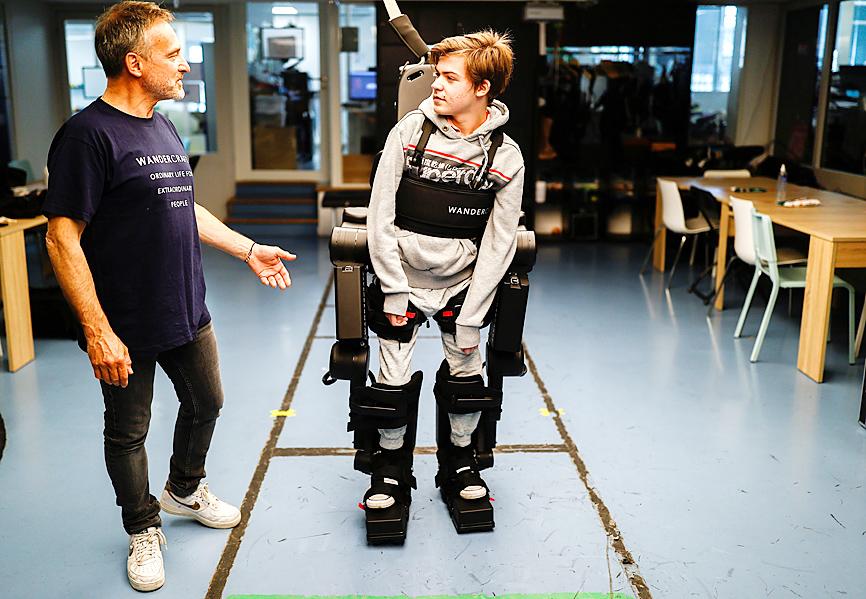Oscar Constanza, 16, gives the order: “Robot, stand up” and slowly but surely a large frame strapped to his body lifts him up and he starts walking.
Fastened to his shoulders, chest, waist, knees and feet, the exoskeleton allows Constanza — who has a genetic neurological condition that means his nerves do not send enough signals to his legs — to walk across the room and turn around.
“Before, I needed someone to help me walk ... this makes me feel independent,” Constanza said, as his father, Jean-Louis Constanza, one of the cofounders of the company that makes the exoskeleton, looked on.

Photo: Reuters
“One day Oscar said to me: ‘Dad, you’re a robotic engineer, why don’t you make a robot that would allow us to walk?’” his father said, speaking at the company Wandercraft’s headquarters in Paris. “Ten years from now, there will be no, or far fewer, wheelchairs.”
Other companies across the world are also manufacturing exoskeletons, competing to make them as light and usable as possible. Some are focused on helping disabled people walk, others on a series of applications, including making standing less tiring for factory workers.
Wandercraft’s exoskeleton, an outer frame that supports, but also simulates body movement, has been sold to dozens of hospitals in France, Luxembourg and the US for about 150,000 euros (US$176,000) each, Jean-Louis Constanza said.
It cannot yet be bought by private individuals for everyday use — that is the next stage the company is working on.
A personal skeleton would need to be much lighter, Wandercraft engineers said.
Just outside Paris, 33-year-old Kevin Piette, who lost the ability to walk in a bike accident 10 years ago, tries one on.
“In the end it’s quite similar: Instead of having the information going from the brain to the legs, it goes from the remote controller to the legs,” he said, before making his dinner and walking with it from the kitchen to the living room.

NO EXCUSES: Marcos said his administration was acting on voters’ demands, but an academic said the move was emotionally motivated after a poor midterm showing Philippine President Ferdinand Marcos Jr yesterday sought the resignation of all his Cabinet secretaries, in a move seen as an attempt to reset the political agenda and assert his authority over the second half of his single six-year term. The order came after the president’s allies failed to win a majority of Senate seats contested in the 12 polls on Monday last week, leaving Marcos facing a divided political and legislative landscape that could thwart his attempts to have an ally succeed him in 2028. “He’s talking to the people, trying to salvage whatever political capital he has left. I think it’s

Polish presidential candidates offered different visions of Poland and its relations with Ukraine in a televised debate ahead of next week’s run-off, which remains on a knife-edge. During a head-to-head debate lasting two hours, centrist Warsaw Mayor Rafal Trzaskowski, from Polish Prime Minister Donald Tusk’s governing pro-European coalition, faced the Eurosceptic historian Karol Nawrocki, backed by the right-wing populist Law and Justice party (PiS). The two candidates, who qualified for the second round after coming in the top two places in the first vote on Sunday last week, clashed over Poland’s relations with Ukraine, EU policy and the track records of their

UNSCHEDULED VISIT: ‘It’s a very bulky new neighbor, but it will soon go away,’ said Johan Helberg of the 135m container ship that run aground near his house A man in Norway awoke early on Thursday to discover a huge container ship had run aground a stone’s throw from his fjord-side house — and he had slept through the commotion. For an as-yet unknown reason, the 135m NCL Salten sailed up onto shore just meters from Johan Helberg’s house in a fjord near Trondheim in central Norway. Helberg only discovered the unexpected visitor when a panicked neighbor who had rung his doorbell repeatedly to no avail gave up and called him on the phone. “The doorbell rang at a time of day when I don’t like to open,” Helberg told television

A team of doctors and vets in Pakistan has developed a novel treatment for a pair of elephants with tuberculosis (TB) that involves feeding them at least 400 pills a day. The jumbo effort at the Karachi Safari Park involves administering the tablets — the same as those used to treat TB in humans — hidden inside food ranging from apples and bananas, to Pakistani sweets. The amount of medication is adjusted to account for the weight of the 4,000kg elephants. However, it has taken Madhubala and Malika several weeks to settle into the treatment after spitting out the first few doses they